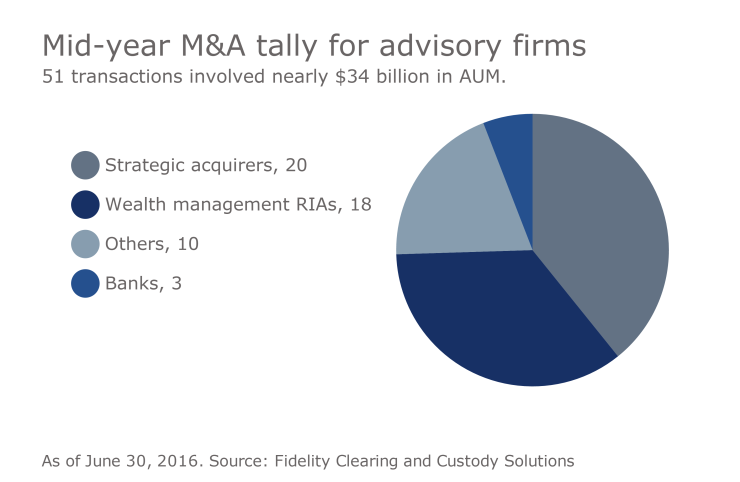If an RIA is thinking of selling, chances are good that it will encounter a strategic acquirer.
These buyers accounted for nearly half of M&A transactions last year and nearly 40% of acquisitions for the first half of 2016, according to Fidelity Investment's latest Wealth Management M&A Transaction report.
Read more:
Who are these strategic acquirers?
Fidelity divides them into five categories, excluding private equity, and firms considering selling should examine their offerings and business models extremely carefully, says David Canter, executive vice president, practice management and consulting for Fidelity clearing & custody solutions.
"What will they look like in five years?" Canter says sellers should be asking. "What is their trajectory?"
Here's what RIA sellers should know about these buyers:
Integrated Platform Provider
Examples: Dynasty Financial Partners, HighTower Network, FinLife Partners (United Capital)
What they do: For a fee, RIAs can outsource their back office, compliance, research and portfolio management needs to platform providers, who can also provide capital to finance transitions from a wirehouse to independence, partner buy-ins and acquisitions.
What they don't do: No equity involved; platform providers aren't looking for ownership or control.
Who fits: Breakaway brokers and existing RIAs who want to scale up their business with a turnkey outsourcing solution, not sweat the technical details and spend more time with clients.
Caveat emptor: Review fees carefully. Once client firms have learned the ropes and added assets, do they still need the middleman?
Canter's take: "For many firms, this option is the lightest touch if they want to grow, get support and capital but not give up any control."

Passive Investor
Examples: Fiduciary Network
What they do: Provide capital for growth, acquisitions and tuck-ins as a long-term, mostly hands-off investor.
What they don't do: Other than capital and financial expertise, operational support is limited.
Who fits: Established, well-managed firms looking to transition to next-generation leadership with minimal outside interference.
Caveat emptor: Review numbers in deal terms carefully. Remember passive cuts both ways.
Canter's take: "A good option for a well-run firm that needs capital with maximum operational flexibility."
Financial Acquirer
Examples: AMG Wealth Partners
What they do: Buy large wealth management firms with stellar track records and high margins. Provide significant amounts of capital as well as financial and M&A expertise. They're the owners but let firms operate independently.
What they don't do: Operating support and interaction with other firms owned by parent is limited.
Who fits: Very successful firms with a strong regional presence and $1 billion or more in AUM.
Caveat emptor: Make sure you're comfortable with ownership and business model.
Canter's take: "Capital, established leadership and long-term commitment are all in place, but know what business problems you're trying to solve."
Strategic Aggregator
Examples: Focus Financial Partners
What they do: Buy into RIAs offering equity and cash; provide capital and support for operations, growth and acquisitions. RIAs have autonomy but can tap into expertise and community of large network of like-minded firms.
What they don't do: Provide centralized management.
Caveat emptor: If equity is the coin of the realm, when —and how—will public markets be accessed?
Canter's take: "The family is bigger and there is access to loans and capital but branding isn't unified."
Branded Acquirer
Examples: United Capital, HighTower Partners, Mariner Holdings
What they do: Acquire RIAs with cash and equity. Firms are integrated into a strong brand, unified platform and large national network with centralized management and marketing.
What they don't do: Let firms march to their own drummer.
Caveat emptor: Acquired firms are giving up control.
Canter's take: "This option is the highest degree of change for sellers."





